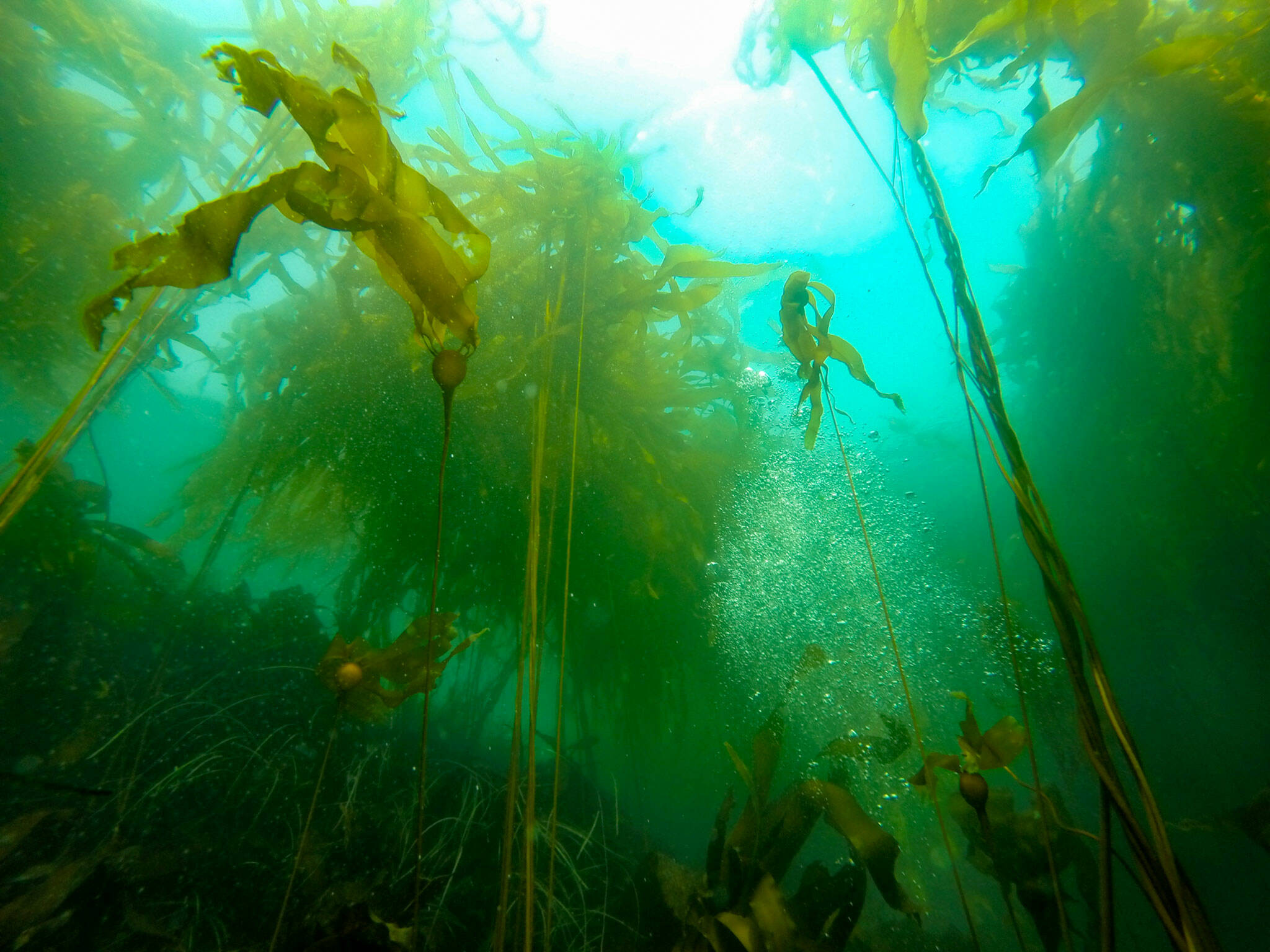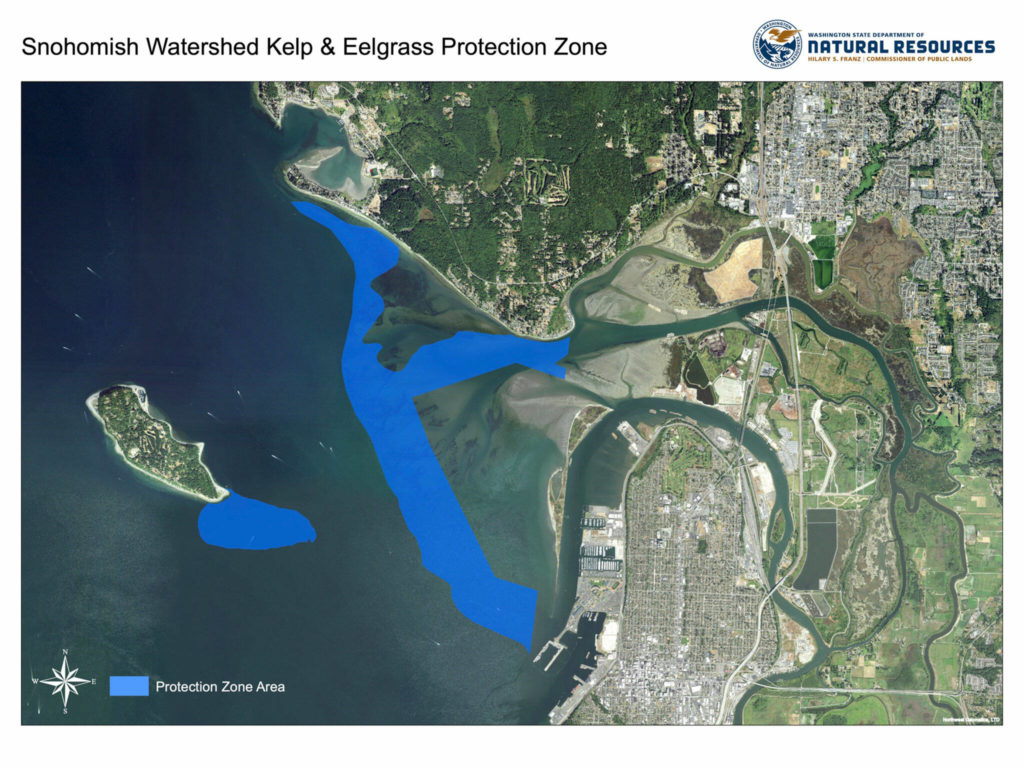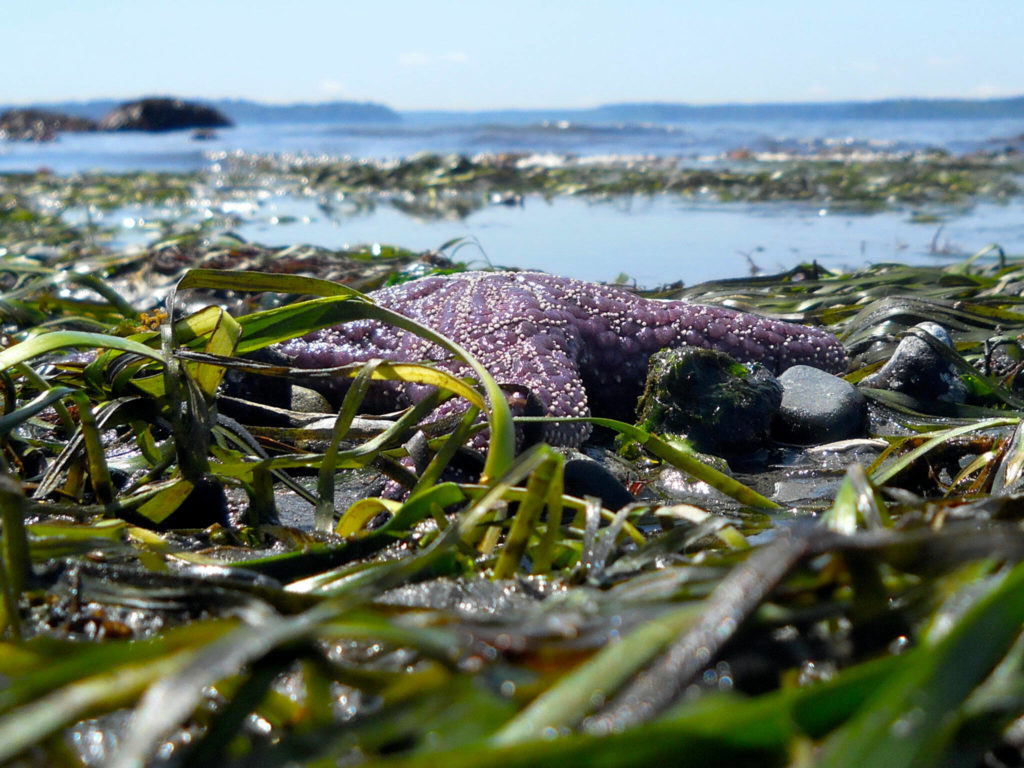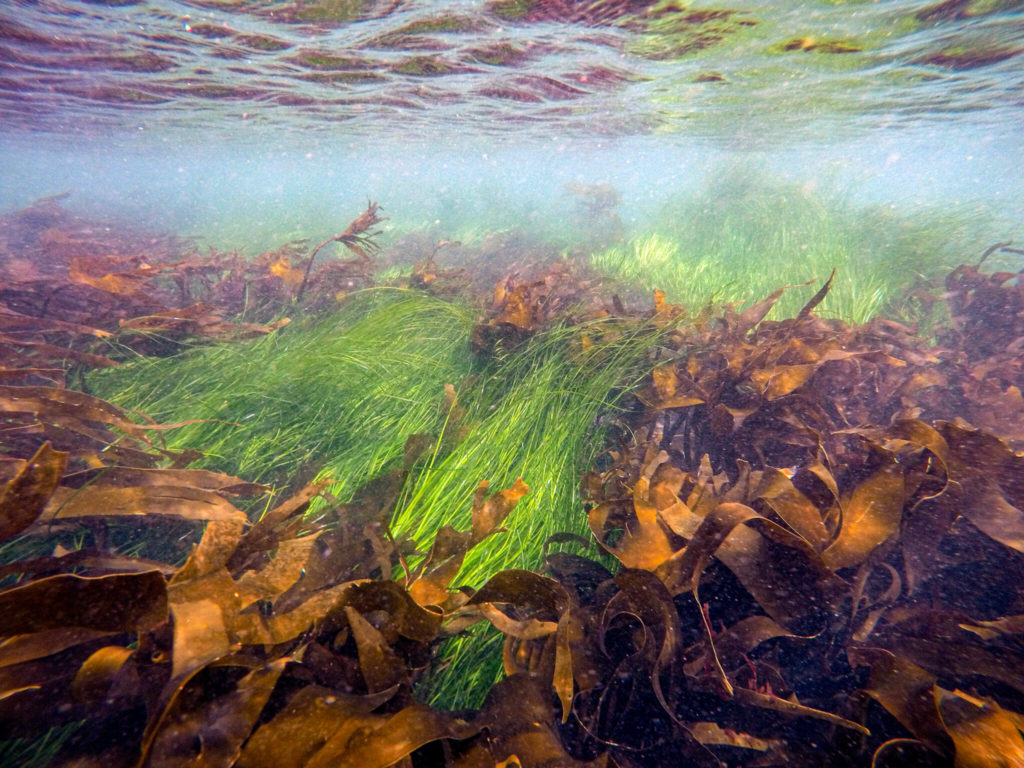EVERETT — Washington is famous for trees — the evergreen conifers that tower into the sky. But the state’s underwater forests are now gaining attention, and new protections.
Seagrass and bull kelp are iconic on Puget Sound beaches. If you’ve gone on a coastal stroll at low tide, you’ve probably seen them. Seagrass, piles of slick-slippery greenery that tangle up the legs of unknowing swimmers. And bull kelp, long and bulbous staff-like things, used by children and adults alike as a sort of play-sword.
Bull kelp stalks can grow up to 130 feet tall, anchored at the rocky bottom with a rooty holdfast and topped off with a round gas bladder that lifts the whole thing toward the surface — sporting a hairdo of long fronds that flow with the current, absorbing nutrients and sunlight.
Marine vegetation supports a whole underwater food web. Small critters nibbling on the plants become snacks for bigger sea dwellers, like rockfish and salmon, and in turn they become food for yet larger animals, such as harbor seals, orcas or people.
There are over 20 types of kelp in Puget Sound, but bull kelp is the most ubiquitous. Canopies of it hang on the water’s surface. Forests of it have the potential to store more excess carbon than their counterpart trees on land, and reduce the effects of ocean acidification. They also disperse waves, creating calmer waters where fish can hang out.
Despite all the benefits, such greenery has been on the decline in Puget Sound, due to a number of factors. But now, in Snohomish County, there is movement to understand these underwater forests, what makes them tick, and protect them.
A new protection zone
Last month, state Public Lands Commissioner Hilary Franz signed an order that will prevent any development within 2,300 acres of marine habitat for the next 50 years. The 50-year protection zone includes a forest of bull kelp at the southern tip of Hat Island, as well as eelgrass meadows along the Snohomish River delta and the shoreline of the Tulalip Reservation.
“They’re critical to the survival of our dwindling salmon and orca populations and act as a vital indicator of the health of our waterways because they respond so quickly to changes in water quality,” Franz said in a statement. “Climate change doesn’t just impact our lands, it impacts our waters. We are witnessing a precipitous decline in kelp and eelgrass throughout Puget Sound.”
Franz calls kelp and eelgrass “the breadbasket of the Salish Sea.” They provide habitat for juvenile salmon, herring, rockfish and abalone, giving them shade and protection from predators, allowing them to grow.
The move is a big first step toward the department’s goal of preserving 10,000 acres of kelp and eelgrass by 2040 — a goal signed into law by Gov. Jay Inslee at the end of March. Senate Bill 5619, requested by Natural Resources and sponsored by Sen. Liz Lovelett, D-Anacortes, passed both chambers nearly unanimously, save a single nay in the House.
This particular zone covers prime real estate outside the mouth of the Snohomish River. Young salmon there are swimming out into the ocean and all of its dangers for the first time. Every piece of grass and kelp helps.
Franz announced her intention to tackle the issue of kelp and eelgrass last month when she unveiled the Snohomish Watershed Resilience Plan, a “tree to sea” approach that aims to address issues throughout the entire watershed. It calls for continued monitoring, increasing coverage of the vegetation, educating the public to reduce habitat damage and pursuing funding, among other objectives.
The protection zone also builds on goals laid out in the multi-partner 2020 Puget Sound Kelp and Conservation Plan and the Department of Natural Resources’ 2015 Eelgrass Recovery Strategy.
The effort to save bull kelp and eelgrass is a team effort of numerous agencies, local governments, nonprofits, scientists and volunteers — including Snohomish County and the Tulalip Tribes.
There was no known development planned within the zone, though it’s possible people could have built docks and piers out into the water. Existing underwater cables, like those stretching out to Hat Island, will be an exception to the rule, according to a copy of the withdrawal order.
More than stopping development, the move to establish a protection zone is symbolic, as well: The state wants to do something to preserve and restore marine vegetation.
But first, there’s a lot of learning to do, about how much bull kelp and eelgrass there is, and how it thrives, or why it dies.
Surveying the seas
Compared to trees and plants on land, little is known about marine vegetation. Scientists and volunteers are just beginning to figure out how much of it there is, through aerial surveys, underwater video and even kayaking or standup paddleboarding.
So far, we know there’s a lot less of it than there used to be.
By comparing old nautical charts with modern day surveys, the state estimates Puget Sound has lost some 80% of bull kelp in the past 150 years. It turns out, seafarers back in the day kept pretty good track of bull kelp, because it was considered a navigational hazard. They wanted to be nowhere near the stuff.
Eelgrass meadows have also declined in parts of the state, including around the San Juan Islands, over the past 20 years, according to the state.
In Snohomish County, surveys conducted via kayak by the Marine Resources Committee show a mixed bag. Eelgrass and bull kelp are thriving in some spots and disappearing in others.
That spot off the tip of Hat Island, for example, has remained relatively stable, said Elisa Dawson, a senior planner for Snohomish County’s surface water management program, who staffs the committee.
But in Mukilteo and at Meadowdale beach in Edmonds, kelp beds have disappeared in recent years, she said.
“That doesn’t mean they might never show up, because it is a fluctuating annual plant, but at this time we haven’t seen those beds for the last three years,” Dawson said, “so that’s a concern.”
In some places, like by Mukilteo, eelgrass is now growing where kelp once was. The two plants like to cling to different surfaces, Dawson said. Kelp like rocks. Seagrass, sand. She noticed some spots have gotten sandier, likely from erosion along the shoreline and upriver.
Eelgrass has apparently suffered along Jetty Island, as well. The island gets swarmed each summer by beachgoers, boaters and kite boarders.
Dawson urged people to tread lightly around the critical habitat, whether on sea or on land, during low tide.
This year, the Marine Resources Committee will focus on surveys north of the Tulalip Reservation. They hope to gain a full understanding of where marine vegetation is growing throughout all of Snohomish County.
Understanding kelp
Any number of factors can cause the decline of kelp and eelgrass, said Cynthia Catton, science advisor for Natural Resources’ aquatics division. It’s hard to hone in on anything specific.
“We don’t have a good understanding of what’s really causing it yet,” Catton said.
The likely culprit, though, is humans: People trampling around in the intertidal zone, boats anchoring, dredging, pollution. Landslides and development upstream might cause sediment to swarm out into the sea, burying vegetation. And man-made climate change can warm the waters, wilting away the temperature-sensitive underwater plants, especially in areas that aren’t flushed out with cold ocean water as often, such as south Puget Sound.
Additionally, a disproportionate abundance of “predators” might eat too much of the plants.
“Usually there’s a combination of things,” Catton said, “and it’s that combination that’s overwhelming.”
The surveys are important, she said, because they reveal potential problem spots that should be further studied.
“It’s way cheaper … if we can protect what we have, and we don’t wait for it to go away before we can get it back,” she said.
Catton said the first step to restoring kelp and seagrass to their former prominence is to address the underlying stressors first. Without doing that, “no amount of restoration effort is going to get it back,” she said.
It’s Brian Allen’s job to figure out how bull kelp grows. He’s the habitat restoration director for the Puget Sound Restoration Fund, a nonprofit based on Bainbridge Island.
Bull kelp are annuals, he said, like daffodils or tulips. New kelp grows each summer, then typically dies out by winter. Each year brings a new generation. But they’re not good at competing for space with other plants, he said. He called bull kelp an “opportunistic vagabond.” It latches onto rocky surfaces on the sea floor and thrives in moving, swirling waters.
Kelps grow fast, drawing on all the minerals and vitamins and nutrients they can from the watershed and the sun.
They pay it forward, Allen said.
“Kelps are just dumping carbon into the estuary in a way that can be taken up by the rest of the food chain,” he said.
Growing kelp isn’t the hard part, Allen said. People have been doing aquaculture for decades, supplying the world with all sorts of seaweedy snacks.
Rather, Allen and his team are trying to figure how to get bull kelp to grow more naturally, in places it historically grew.
That’s a bit trickier, and so far there is no sure-fire answer. The restoration fund and its scientific partners are conducting trials to see what works and what doesn’t. In the meantime, they’re also learning about bull kelp’s genetics, collecting seeds from different areas to collect a seed bank, and figuring out how it interacts with competitors.
And so the science inches its way forward. But there’s only so much time, Allen said. The water is getting warmer.
“I feel like the clock is ticking on this recovery part,” he said.
Zachariah Bryan: 425-339-3431; zbryan@heraldnet.com. Twitter: @zachariahtb.
Talk to us
> Give us your news tips.
> Send us a letter to the editor.
> More Herald contact information.




























